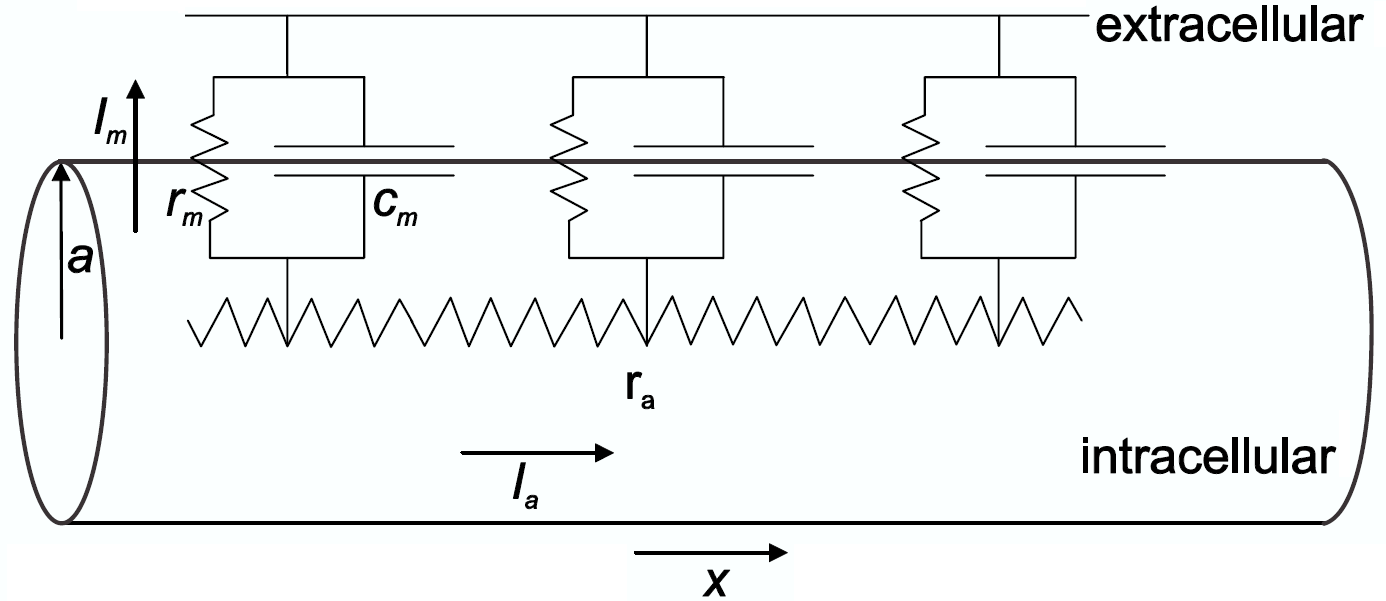Bioelectricity: Passive and activve current flow along an axon
 Passive current flow and the cable equation
Passive current flow and the cable equation
In a space-clamp experiment, the membrane voltage of a prepared area along the nerve fibre is the same. This means that the spatial organization of a cell is not taken into account. However, this approach is not sustainable for a neuron with a long nerve fibre or a highly branched tree structure of dendrites. To describe the charge propagation along a nerve fibre one uses theory about electrical cables. We will first deal with the passive propagation of electric charge along the cell membrane. This means that the properties of the cell membrane are considered to be constant and does not depend, for example, on the membrane potential. You can think of an experiment in which you change the potential at the beginning of the axon by continuous current injection and then go on until no more changes take place in time (this is called a steady state). The membrane potential will then decrease slowly along the axon because current flow will leak through the membrane. We will set up a mathematical formula for this decrease in membrane potential.
Electric cable model of an axon We only discuss a highly simplified model in which
- electrical properties of the cable (for example, membrane capacity, membrane resistance and axial resistance) are the same everywhere;
- the nerve fibre is cylindrical with a constant diameter;
- the extracellular fluid has a negligible resistance (i.e., will be assumed equal to 0 );
- we will work with electric potential with respect to the resting membrane potential to make things easier.
The figure below shows the electrical model of a piece of a cylindrical cable. It shows the electrical properties of the cell membrane with resistance \(r_m\), connected in parallel with the capacitance \(c_m\), and axial resistance \(r_a\) of the intracellular fluid. The membrane is represented as a series of parallel connected resistors and capacitors. \(I_a\) and \(I_m\) are, respectively, the axial current and the membrane current.

The quantities \(r_m\), \(r_a\) and \(c_m\) are always related to a piece of axon of a certain unit length.
The cable equation Consider an axon as a chain of successive pieces that
- each consist of a membrane part which is modelled as a parallel circuit of a resistor and a capacitor;
- are connected among themselves with resistors which describe the flow in the axoplasm (we neglect the resistance of the extracellular fluid)
Assume a cylindrical axon with the axis equal to the positive \(x\) axis. Suppose that change the voltage by current injection at time \(t=0\) in \(x=0\) and maintain the voltage by continuous current injection. This current flows through the axon, but there is also leakage flow through the membrane. This means that the voltage \(V\) is not everywhere the same along the axon and also will depend on time; we indicate this by denoting \(V\) explicitly as a function of place and time, say \(V(x,t)\).
This location- and time-dependent potential is the solution of the following partial differential equation, which is referred to as the cable equation, with boundary value \(V(0,t)=V_0\) : \[\lambda^2\cdot \frac{\partial^2 V}{\partial x^2}=\tau_m\cdot \frac{\partial V}{\partial t}+V, \qquad V(0,t)=V_0\] with \[\lambda=\sqrt{\frac{r_m}{r_a}}=\sqrt{\frac{a\cdot R_m}{2R_a}},\quad\tau=r_m\cdot c_m=R_m\cdot C_m\] After a sufficiently long time, the membrane potential along the axon will not change over time. We can then consider the membrane voltage as a function \(V(x)\) and the partial differential equation becomes the following ordinary differential equation \[\lambda^2\cdot \frac{\dd^2V}{\dd x^2}=V, \qquad V(0)=V_0\] The solution to this initial value problem is an exponential decay curve \[V(x)=V(0)\cdot e^{-\frac{x}{\lambda}}\]


